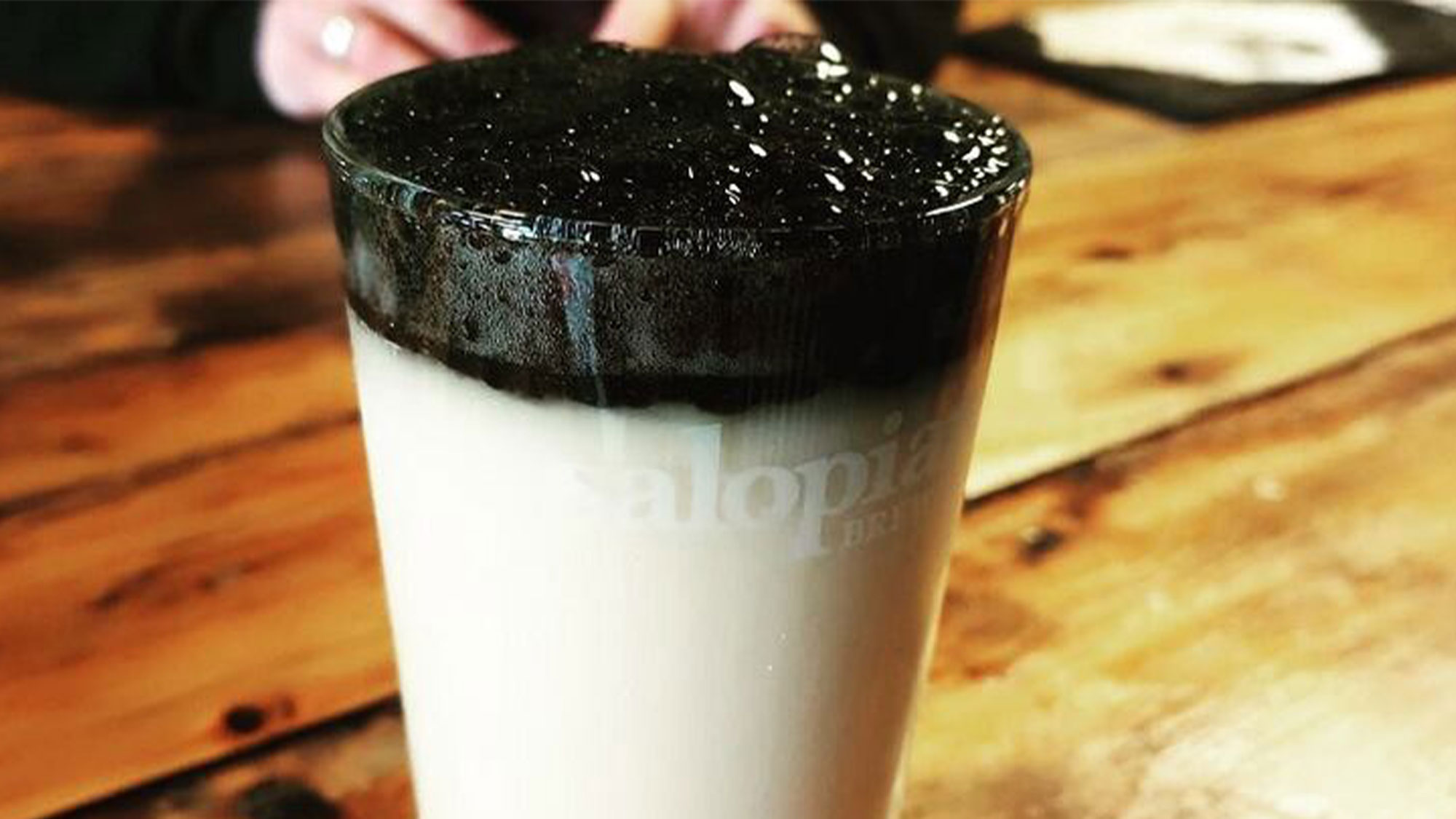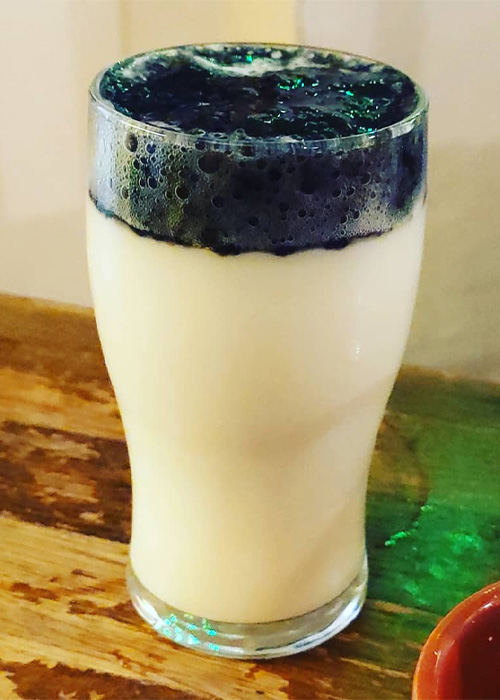


There’s been a lot of innovation in the stout category since the early ‘90s. 1992 saw Chicago’s Goose Island Brewery become the first to age stouts in bourbon barrels. In 2014, brewer Derek Gallanosa pioneered imperial pastry stouts. And now many breweries even make sour versions of the style.
On one hand, the rampant experimentation that’s occurred in the category over the past 30-plus years has resulted in some beautiful, decadent brews. However, in an era when little is sacred anymore in the brewing industry, many brewers have a tendency to produce beers that walk the line between unorthodox and flat-out hair-raising.
One such example came in the form of Sinistral, a white stout released by Gazza Prescott and Sue Howard of U.K. brewery Team Toxic in 2019. The fact that the stout was completely white was only half of its rather unholy nature. Up top, it bore a ghastly pitch black head, earning it the nickname “Reverse Guinness.”
White stout isn’t officially recognized by the Beer Judge Certification Program, so there are no hard and fast rules dictating how, or how not to, brew these beers, but the basic premise is crafting something that tastes like a stout without looking like one. According to beer publication Craft Beer & Brewing, the general consensus is “White (or Pale, though some use that to describe a beer that’s more amber than pale) Stout is predominately a blonde or golden ale of moderate-to-somewhat high alcohol strength that also exhibits traditional ‘stout’ flavors such as coffee and chocolate.” Some brewers use adjuncts like lactose, coffee, and chocolate to mimic stout’s flavor profile and creamy mouthfeel. Others opt for flaked barley, lightly roasted barley, and pale chocolate malts.
Given that these beers are typically pale to amber in color, the name “white stout” is more of a marketing ploy than an accurate descriptor, but that’s exactly what inspired the folks at Team Toxic to brew Sinistral. “We wanted it white, not just very pale,” Prescott says.
As Prescott explains, brewing a milky white beer is no simple feat. “The main challenge was the color,” he says. “Beer can’t be made white by conventional means so we made the palest beer we could, then whitened it.” Exactly how he and Hayward did so remains a company secret, but Prescott says that they didn’t achieve the color with natural beer ingredients. “One big issue we had was that the white color started to drop out of suspension fairly quickly,” he explains. “We had to shake the kegs every 15 minutes [when serving it].”
To be clear, Sinistral, which means “left-handed,” was the name of the beer. “Reverse Guinness” was just a media-given moniker that came about once Prescott and Hayward decided to give the white stout a black, bubbly, tar-like head. “The project was always 100 percent that it should taste like a dark beer, reversed — as a Black IPA does,” Prescott says. “We didn’t consider Guinness at all. Really, that wasn’t our intention.”
However, given that Team Toxic was founded just a year prior to the beer’s release as a small operation, the two brewers conjured up the idea of a black head as a way to grab attention, grow their business, and poke a little fun at beer purists in the process.
“It was to prove that a tiny outfit like us could do something like this — and to show how cliquey and regimented craft beer hipsters are,” Prescott says. “We got plenty of ‘who do you think you are?’ comments, whereas if this had been done by Omnipollo or one of the big craft brewers they’d have been feted as heroes.”
Much like making the beer white, achieving the infamous black head was no easy task, and the duo quickly discovered that it would have to be prepared separately from the stout and then manually added to each pint after pouring. “We had the same issues with making it the color we wanted without using any off-putting flavors,” Prescott says. “I can confirm we did try stuff like squid ink which smelt horrible, and it [did contain] a slight hint of butterscotch which added to the overall flavor.” Regardless of whatever other secret ingredients made up the ominous-looking slurry, Prescott explains that he wound up pouring the beer with as small a head as possible and then used chef’s cream dispensers charged with carbon dioxide and nitrogen to top off each pint à la minute.

“The head was a touch viscous and gloopy, but it seemed to be fine out in the real world,” he says. “Obviously, it was attention-seeking, but we wanted to grow the business and saw this as a step to becoming more famous.”
And boy oh boy did it work.
Team Toxic’s initial — and only — batch of Sinistral yielded roughly 1,200 liters of beer. Due to the fact that the stout’s head needed to be added separately and the kegs required intermittent shaking, Prescott and Hayward embarked on a pub tour. They traveled around the U.K., supplying bars with the necessary components to serve Sinistral and teaching bartenders how to serve the beer.
“We’d only serve it as part of a tap takeover where bars took 12 beers from us,” Precostt says. “It worked really well. We also did a ‘league table’ to see which pubs sold their keg [of Sinistral] the fastest in one night. I think the winner was the Paper Mill Micropub in Sittingbourne, Kent, where it only lasted 15 minutes.”
It wasn’t long before the media caught wind of the beer and gave it the “Reverse Guinness” name. Several publications reported that the stout was selling like hotcakes at every pub that had it.
After U.K. pubs had drained the initial batch of Sinistral, the pandemic hit right as Prescott and Hayward were getting ready to brew another. “Covid ultimately killed off the business,” Prescott says. “When Sue left the company to do other things, we decided that I’d not brew it again.”
Although Sinistral is no more, it serves as an example of how beer drinkers tend to appreciate a good gimmick — at least in the short term. Consider the Oklahoma Martini, the Gonster, or the Beer Ball keg. Concerning the appeal of “Reverse Guinness,” one Beer Advocate user arguably said it best: “Looks disgusting. I’d drink it!”
*Image retrieved from Team Toxic via Facebook
The article A White Stout With a Black Head: Remembering Britain’s ‘Reverse Guinness’ appeared first on VinePair.